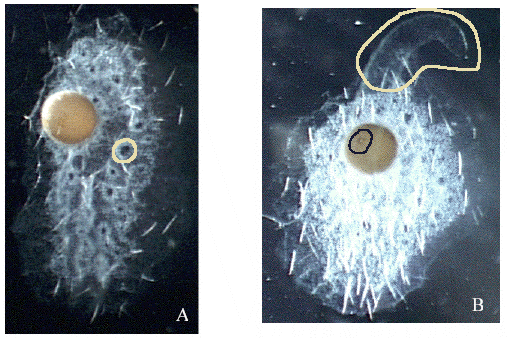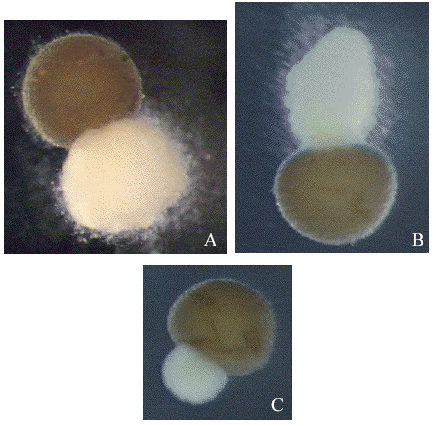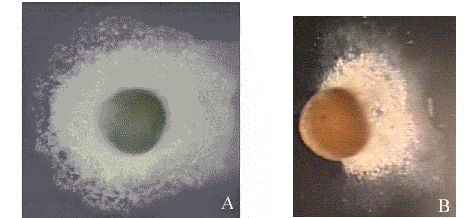Malcolm S. Hill and April L. Hill
Background
Since receiving the ABLE Laboratory
Initiative grant last summer, we have been working on a lab that deals
with the use of freshwater sponges as indicators of water pollution. Specifically,
the focus of this laboratory module is on the effects that chemicals of
environmental concern (e.g., endocrine disrupters) have on sponge growth
and development. Contamination of aquatic ecosystems is a serious issue
in environmental science. Identifying which chemicals we should be concerned
with, and determining the consequences of contamination by specific compounds,
is a major area of current research. Undergraduates are constantly exposed
to news of environmental deterioration, yet few have an idea of how bioassays
can help set national drinking water standards or shape environmental
guidelines/laws. Our laboratory activity represents an introduction to
this area of biological exploration with an unusual animal model.
Biology of Freshwater Sponges
Freshwater sponges are common animals of most aquatic
ecosystems. They utilize flagellated choanocytes to pump water through
a series of canals. Incoming water enters through ostia, passes through
choanocyte chambers, and exits through the osculum. Bacteria are filtered
from incoming water, and large volumes of water can pass through a sponge
in a 24-hour period. Due to their simple morphological construction, many
cells come into direct contact with the surrounding water as the sponge
pumps. Thus, a sponge's mode of feeding results in high levels of exposure
to any compound present in an ecosystem. Watanabe and colleagues ("Life
of the Freshwater Sponge", 1998, produced by Tokyo Cinema, Inc.) have
produced a beautiful film using time-lapse videography to document the
life cycles and water purification role of freshwater sponges. The running
time of the film is 28 mins, and shows sponges in their natural environment.
This film was produced by the BBC, and would make a nice introductory
presentation to the topic.
A useful aspect of freshwater sponge biology (at least for the purposes of an undergraduate lab module) is the fact that they enter diapause as small gemmules. Gemmules are overwintering balls that are produced in the late summer/early fall by the adult sponge. Adult tissue disintegrates around the gemmule during the winter, and a new sponge emerges from the gemmules in the spring. The newly developing sponge exits the gemmule from a micropyle, and then quickly spreads around the gemmule. In a healthy sponge, a water vascular system is evident, and many sponges produce a long, striking osculum (Fig. 1). Gemmules may be stored for years at 4˚C and still remain viable.

Figure 1. In control or low concentration treatments, sponge growth is normal. Notice the well-defined choanotcytic chambers indicated by the circle (A) and the large osculum indicated by the large circle (B).
There are several other reasons why sponges are a model laboratory organism to explore the biological consequences of environmental pollution. For the purposes of ease of set-up, sponges represent a cost and time effective study organism. They are readily available at a low cost from the major teaching supply companies (e.g., Connecticut Valley Biological, Carolina Biological Supply Company). Finally, gemmules grow relatively quickly (within 3-5 days) and require very little equipment to grow (a few tissue culture plates, and a room of fairly constant temperature and photoperiod).
Laboratory Goals-Progress Report
This lab will introduce students to a simple bioassay
that will allow them to explore the effects that a chemical's concentration
has on the level of toxicity. By relying on morphological examination
of sponges hatching from gemmules that are smaller than a millimeter in
diameter, this module will help students develop their microscopy skills.
Our major aim, however, is to have students strengthen their ability to
design and test their own hypotheses. After students have familiarized
themselves with the basics of the freshwater sponge life cycle, they would
be expected to propose a hypothesis about the effects of pollutants on
sponge growth and morphology. The students would be guided in the design
of an experiment to examine 1) the effects of chemicals of their choice
on sponge growth, and 2) the effects of pollutant concentration on sponge
growth. The choice of chemicals would be at the discretion of the instructor,
but our work has focused on endocrine disrupters (e.g., ethyl benzene,
nonylphenol). As the experiments progress, students will be able to detect
major growth abnormalities immediately (Fig 2), but should also look for
developmental abnormalities such as the absence of a well-defined water
vascular system (Fig 3). As mentioned earlier, normal sponge growth typically
includes the production of a distinct water vascular system with a less
dense cellular construction (Fig 1). We hope that results from this laboratory
can be used for a discussion of the biological consequences of pollution
and will provide students with an appreciation for how dilution influences
a chemical's biological effect. {While we have focused specifically on
the effect that chemical pollutants have on sponge growth, sponge gemmules
provide a host of other hypothesis testing possibilities (e.g., effects
of temperature, light, food concentration, water oxygen content, etc.
on rates of gemmule hatching).}

Figure 2. Sponge growth in our concentrated methyl paraben (A), nonylphenol (B), and ethyl benzene (C) treatments was highly anomalous. Newly produced tissue exited the micropyle as a tight tube which was drastically different from a "normal" sponge.

Figure 3. Sponges grown in solutions with medium or low concentrations of chemicals often displayed unusual growth forms or failed to produce a water vascular system.
We have spent the past year identifying chemicals that cause gross morphological defects in sponge growth. As can be seen in the accompanying figure, the effects of a number of chemicals can have a significant effect of sponge morphology. This abnormality appears to be a common response by sponges to many organic compounds since other researchers have observed this response. The compounds we used in our trials produced dramatic effects within 3 d. An incomplete list of compounds that we have tested includes: nonylphenol, ethyl benzene, toluene, methyl paraben, benzo-a-pyrene, and bisphenol-a. We attempted to choose compounds that would be commonly encountered in a student's daily life (e.g., methyl paraben is used in sunscreens and in the color coatings of many candies). Countless other compounds would work equally well.
As we prepare our final report to the members of ABLE for the Chicago meeting, we would appreciate any feedback or suggestions that might improve this laboratory module (email Malcolm or April ).
Malcolm S. Hill and April
L. Hill
Biology Department
Fairfield University
Fairfield, CT 06430
ã 2000 ABLE. All rights reserved.